Announcement: Chapter quizzes are not working as of summer 2023.
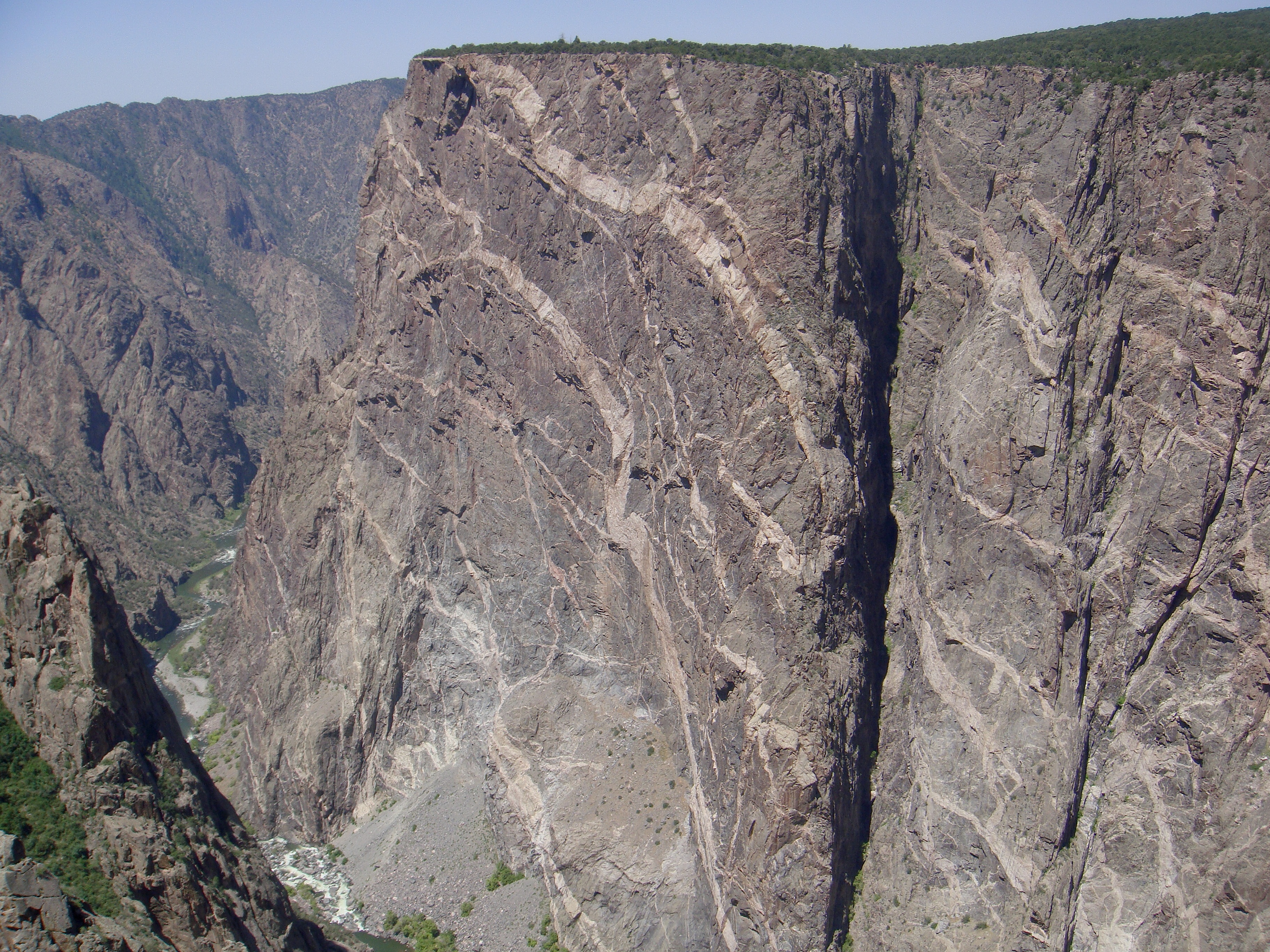
6 Metamorphic Rocks
Contributing Author: Dr. Peter Davis, Pacific Lutheran University
KEY CONCEPTS
- Describe the temperature and pressure conditions of the metamorphic environment
- Identify and describe the three principal metamorphic agents
- Describe what recrystallization is and how it affects mineral crystals
- Explain what foliation is and how it results from directed pressure and recrystallization
- Explain the relationships among slate, phyllite, schist, and gneiss in terms of metamorphic grade
- Define index mineral
- Explain how metamorphic facies relate to plate tectonic processes
- Describe what a contact aureole is and how contact metamorphism affects surrounding rock
- Describe the role of hydrothermal metamorphism in forming mineral deposits and ore bodies
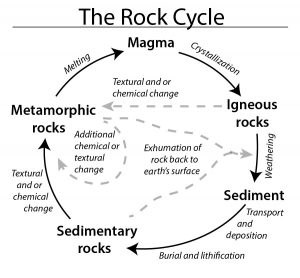
Metamorphic rocks, meta- meaning change and –morphos meaning form, is one of the three rock categories in the rock cycle (see Chapter 1). Metamorphic rock material has been changed by temperature, pressure, and/or fluids.The rock cycle shows that both igneous and sedimentary rocks can become metamorphic rocks. And metamorphic rocks themselves can be re-metamorphosed. Because metamorphism is caused by plate tectonic motion, metamorphic rock provides geologists with a history book of how past tectonic processes shaped our planet.
6.1 Metamorphic Processes
Metamorphism occurs when solid rock changes in composition and/or texture without the mineral crystals melting, which is how igneous rock is generated. Metamorphic source rocks, the rocks that experience the metamorphism, are called the parent rock or protolith, from proto– meaning first, and lithos- meaning rock. Most metamorphic processes take place deep underground, inside the earth’s crust. During metamorphism, protolith chemistry is mildly changed by increased temperature (heat), a type of pressure called confining pressure, and/or chemically reactive fluids. Rock texture is changed by heat, confining pressure, and a type of pressure called directed stress.
6.1.1 Temperature (Heat)
Temperature measures a substance’s energy—an increase in temperature represents an increase in energy. Temperature changes affect the chemical equilibrium or cation balance in minerals. At high temperatures atoms may vibrate so vigorously they jump from one position to another within the crystal lattice, which remains intact. In other words, this atom swapping can happen while the rock is still solid.
The temperatures of metamorphic rock lies in between surficial processes (as in sedimentary rock) and magma in the rock cycle. Heat-driven metamorphism begins at temperatures as cold as 200˚C, and can continue to occur at temperatures as high as 700°C-1,100°C. Higher temperatures would create magma, and thus, would no longer be a metamorphic process. Temperature increases with increasing depth in the Earth along a geothermal gradient (see Chapter 4) and metamorphic rock records these depth-related temperature changes.
6.1.2 Pressure
Pressure is the force exerted over a unit area on a material. Like heat, pressure can affect the chemical equilibrium of minerals in a rock. The pressure that affects metamorphic rocks can be grouped into confining pressure and directed stress. Stress is a scientific term indicating a force. Strain is the result of this stress, including metamorphic changes within minerals.
Confining Pressure
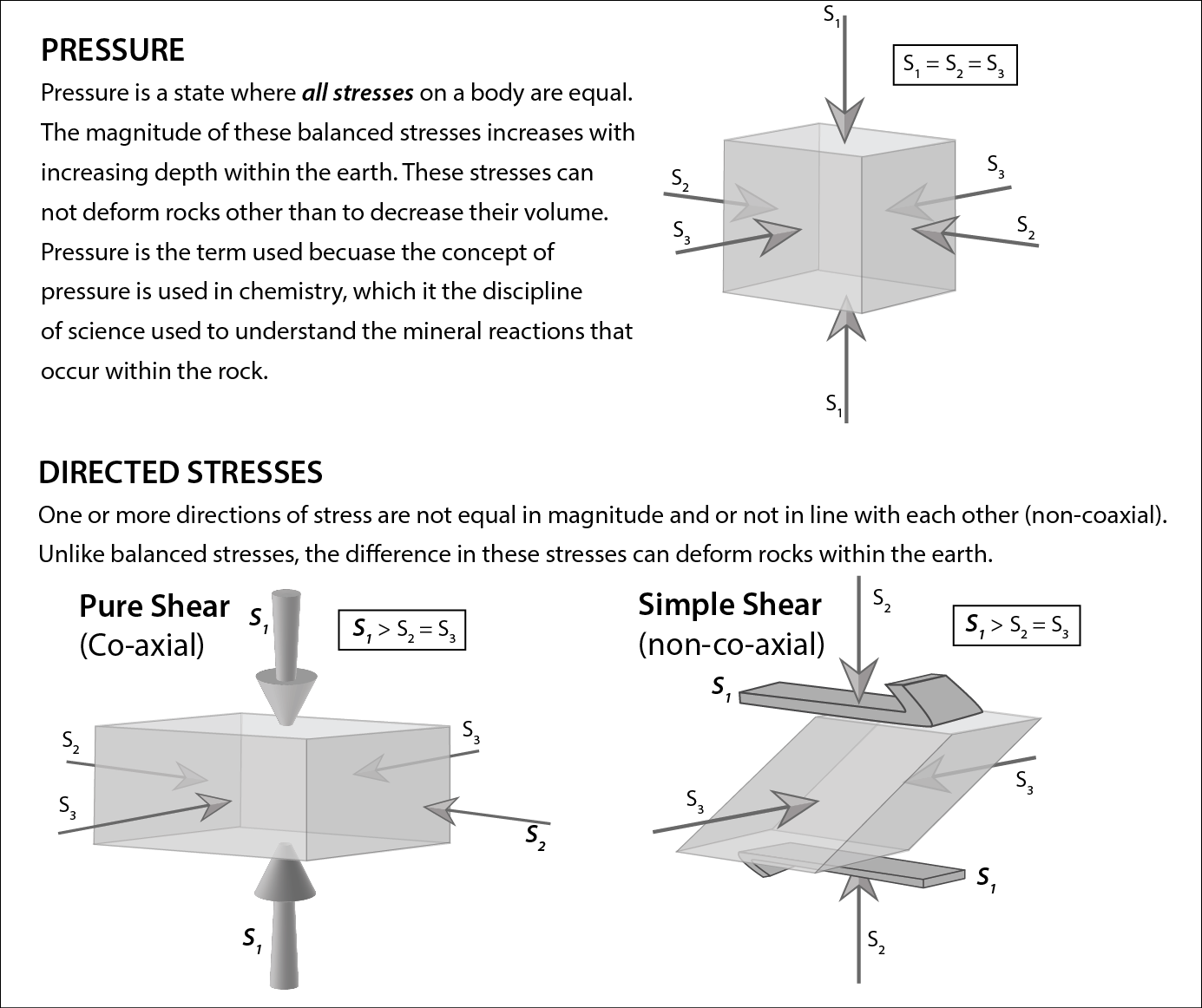
Pressure exerted on rocks under the surface is due to the simple fact that rocks lie on top of one another. When pressure is exerted from rocks above, it is balanced from below and sides, and is called confining or lithostatic pressure. Confining pressure has equal pressure on all sides (see figure) and is responsible for causing chemical reactions to occur just like heat. These chemical reactions will cause new minerals to form.
Confining pressure is measured in bars and ranges from 1 bar at sea level to around 10,000 bars at the base of the crust. For metamorphic rocks, pressures range from a relatively low-pressure of 3,000 bars around 50,000 bars, which occurs around 15-35 kilometers below the surface.
Directed Stress
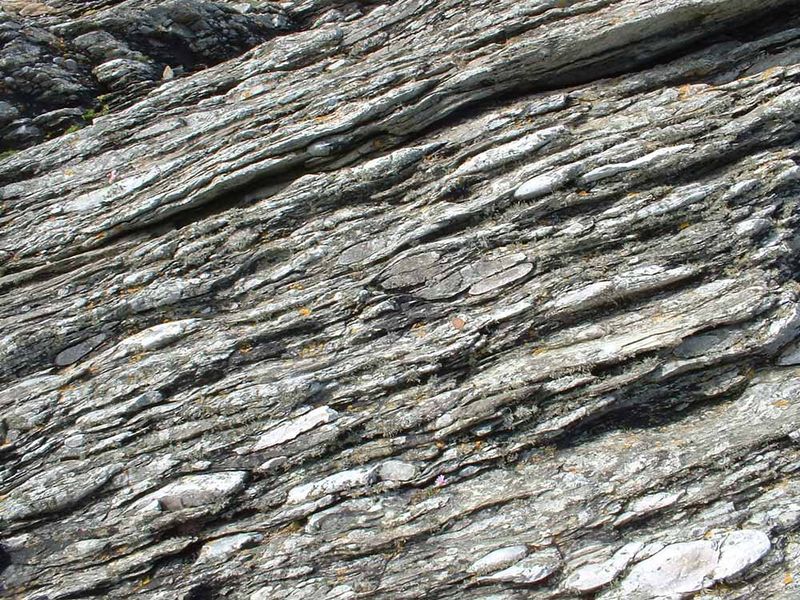
Directed stress, also called differential or tectonic stress, is an unequal balance of forces on a rock in one or more directions (see previous figure). Directed stresses are generated by the movement of lithospheric plates. Stress indicates a type of force acting on rock. Strain describes the resultant processes caused by stress and includes metamorphic changes in the minerals. In contrast to confining pressure, directed stress occurs at much lower pressures and does not generate chemical reactions that change mineral composition and atomic structure. Instead, directed stress modifies the parent rock at a mechanical level, changing the arrangement, size, and/or shape of the mineral crystals. These crystalline changes create identifying textures, which is shown in the figure below comparing the phaneritic texture of igneous granite with the foliated texture of metamorphic gneiss.
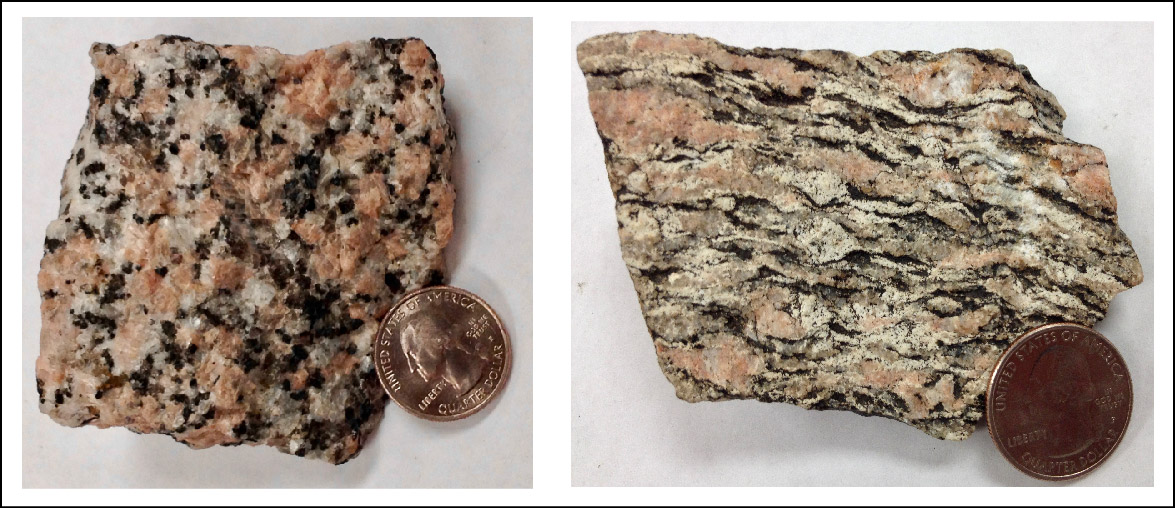
Directed stresses produce rock textures in many ways. Crystals are rotated, changing their orientation in space. Crystals can get fractured, reducing their grain size. Conversely, they may grow larger as atoms migrate. Crystal shapes also become deformed. These mechanical changes occur via recrystallization, which is when minerals dissolve from an area of rock experiencing high stress and precipitate or regrow in a location having lower stress. For example, recrystallization increases grain size much like adjacent soap bubbles coalesce to form larger ones. Recrystallization rearranges mineral crystals without fracturing the rock structure, deforming the rock like silly putty; these changes provide important clues to understanding the creation and movement of deep underground rock faults.
6.1.3 Fluids
A third metamorphic agent is chemically reactive fluids that are expelled by crystallizing magma and created by metamorphic reactions. These reactive fluids are made of mostly water (H2O) and carbon dioxide (CO2), and smaller amounts of potassium (K), sodium (Na), iron (Fe), magnesium (Mg), calcium (Ca), and aluminum (Al). These fluids react with minerals in the protolith, changing its chemical equilibrium and mineral composition, in a process similar to the reactions driven by heat and pressure. In addition to using elements found in the protolith, the chemical reaction may incorporate substances contributed by the fluids to create new minerals. In general, this style of metamorphism, in which fluids play an important role, is called hydrothermal metamorphism or hydrothermal alteration. Water actively participates in chemical reactions and allows extra mobility of the components in hydrothermal alteration.
Fluids-activated metamorphism is frequently involved in creating economically important mineral deposits that are located next to igneous intrusions or magma bodies. For example, the mining districts in the Cottonwood Canyons and Mineral Basin of northern Utah produce valuable ores such as argentite (silver sulfide), galena (lead sulfide), and chalcopyrite (copper iron sulfide), as well as the native element gold. These mineral deposits were created from the interaction between a granitic intrusion called the Little Cottonwood Stock and country rock consisting of mostly limestone and dolostone. Hot, circulating fluids expelled by the crystallizing granite reacted with and dissolved the surrounding limestone and dolostone, precipitating out new minerals created by the chemical reaction. Hydrothermal alternation of mafic mantle rock, such as olivine and basalt, creates the metamorphic rock serpentinite, a member of the serpentine subgroup of minerals. This metamorphic process happens at mid-ocean spreading centers where newly formed oceanic crust interacts with seawater.
![By University of Washington; NOAA/OAR/OER. (NOAA Photo Library: expl2366) [CC BY 2.0 (http://creativecommons.org/licenses/by/2.0) or Public domain], via Wikimedia Commons There is a large build up of minerals around the vent](https://opengeology.org/textbook/wp-content/uploads/2016/07/BlackSmoker.jpg)
[ays_quiz id=”35″]
6.2 Metamorphic textures
Metamorphic texture is the description of the shape and orientation of mineral grains in a metamorphic rock. Metamorphic rock textures are foliated, non-foliated, or lineated are described below.
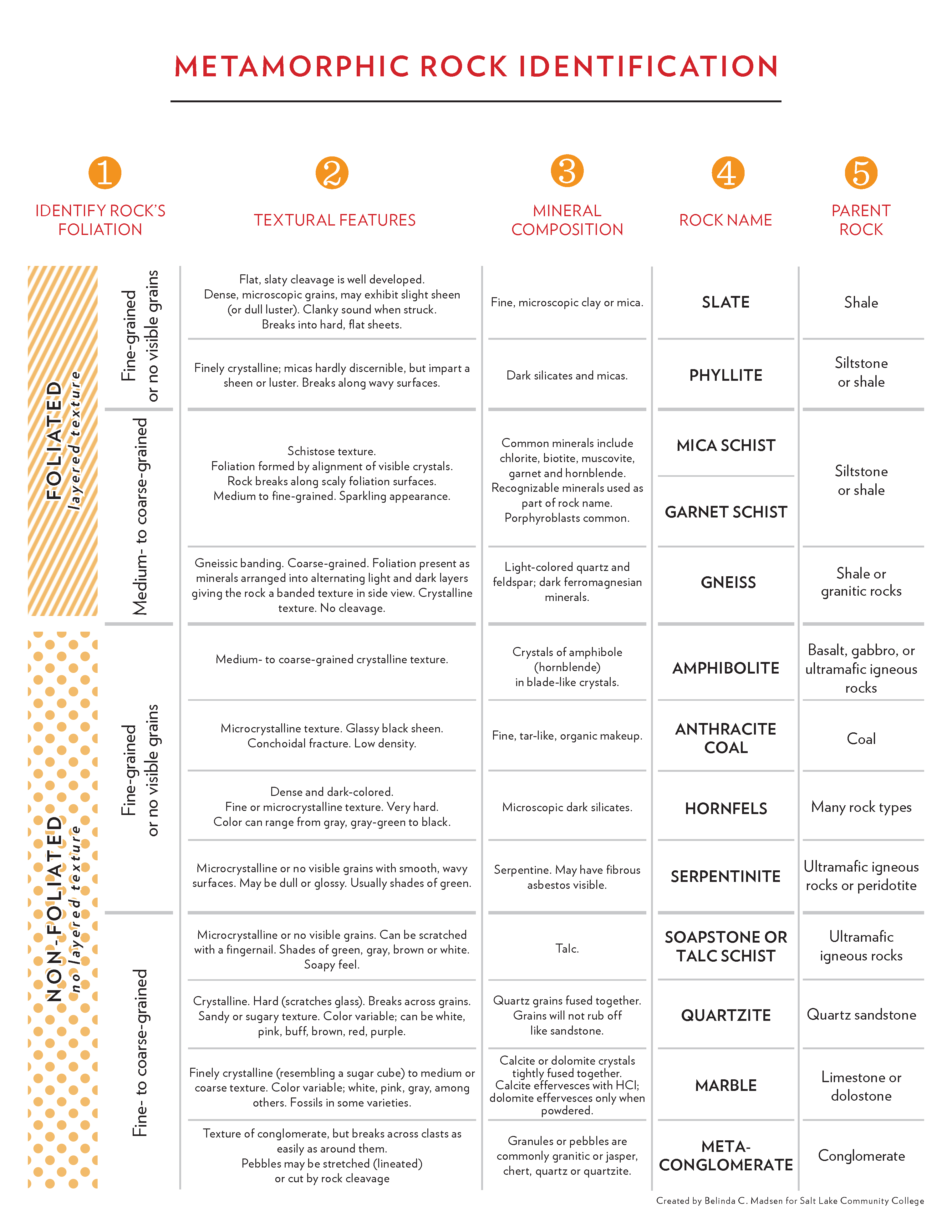
6.2.1 Foliation and Lineation
Foliation is a term used that describes minerals lined up in planes. Certain minerals, most notably the mica group, are mostly thin and planar by default. Foliated rocks typically appear as if the minerals are stacked like pages of a book, thus the use of the term ‘folia’, like a leaf. Other minerals, with hornblende being a good example, are longer in one direction, linear like a pencil or a needle, rather than a planar-shaped book. These linear objects can also be aligned within a rock. This is referred to as a lineation. Linear crystals, such as hornblende, tourmaline, or stretched quartz grains, can be arranged as part of a foliation, a lineation, or foliation/lineation together. If they lie on a plane with mica, but with no common or preferred direction, this is foliation. If the minerals line up and point in a common direction, but with no planar fabric, this is lineation. When minerals lie on a plane AND point in a common direction; this is both foliation and lineation.
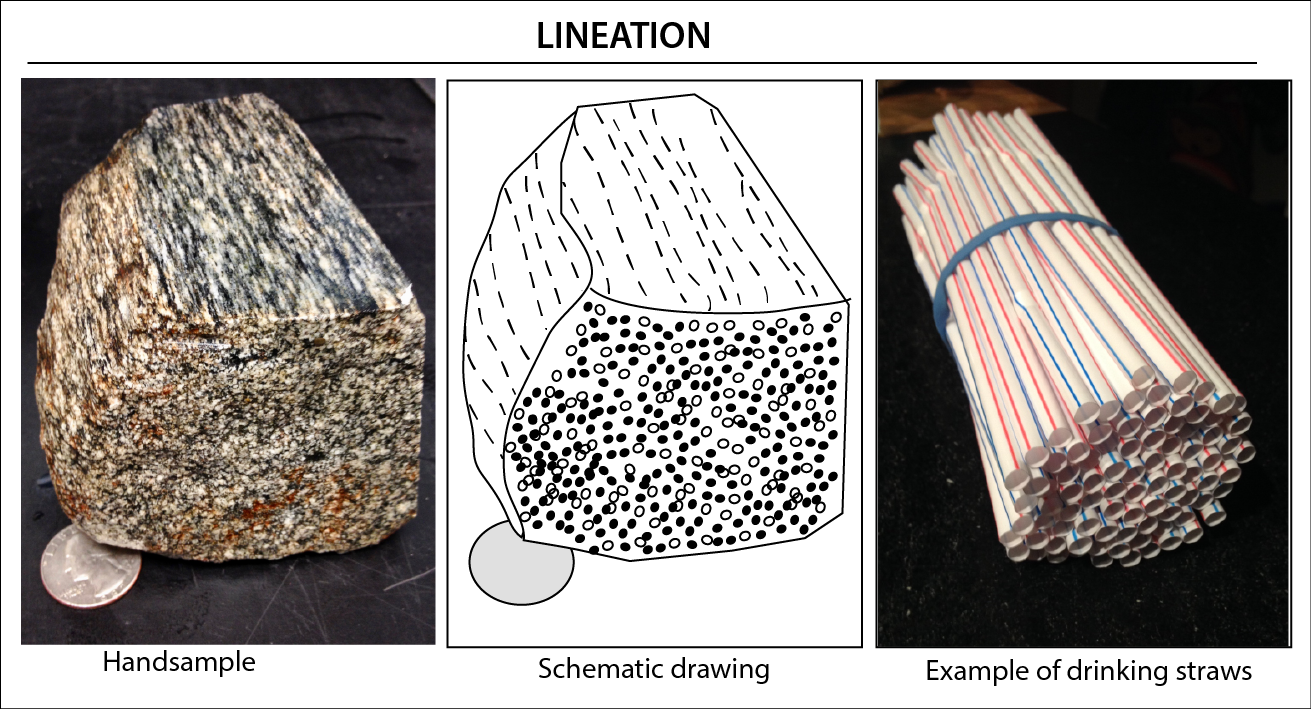
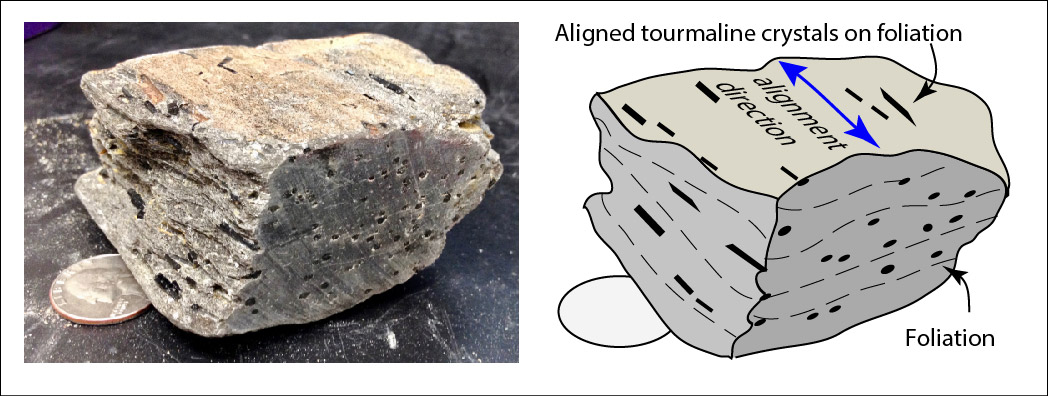
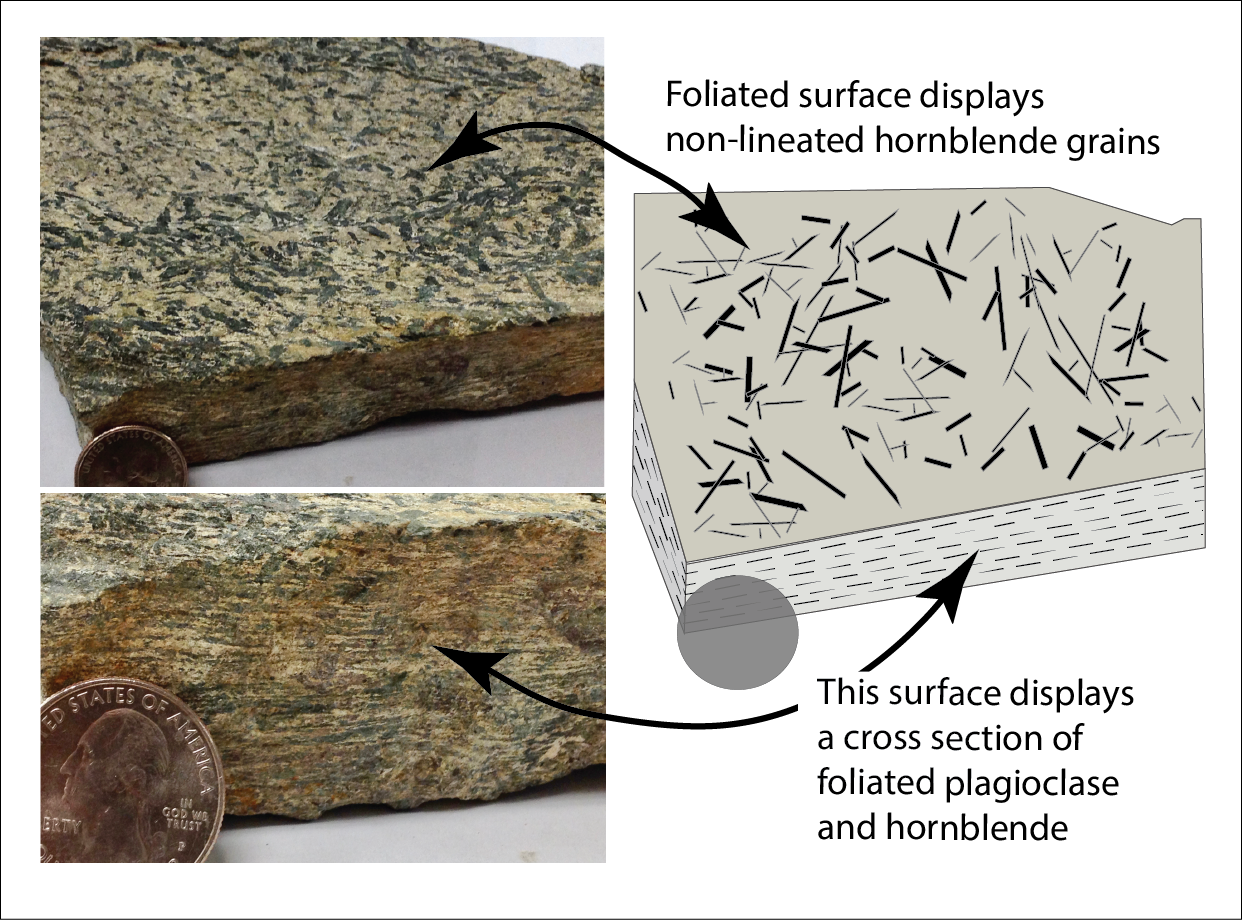
Foliated metamorphic rocks are named based on the style of their foliations. Each rock name has a specific texture that defines and distinguishes it, with their descriptions listed below.
Slate is a fine-grained metamorphic rock that exhibits a foliation called slaty cleavage that is the flat orientation of the small platy crystals of mica and chlorite forming perpendicular to the direction of stress. The minerals in slate are too small to see with the unaided eye. The thin layers in slate may resemble sedimentary bedding, but they are a result of directed stress and may lie at angles to the original strata. In fact, original sedimentary layering may be partially or completely obscured by the foliation. Thin slabs of slate are often used as a building material for roofs and tiles.
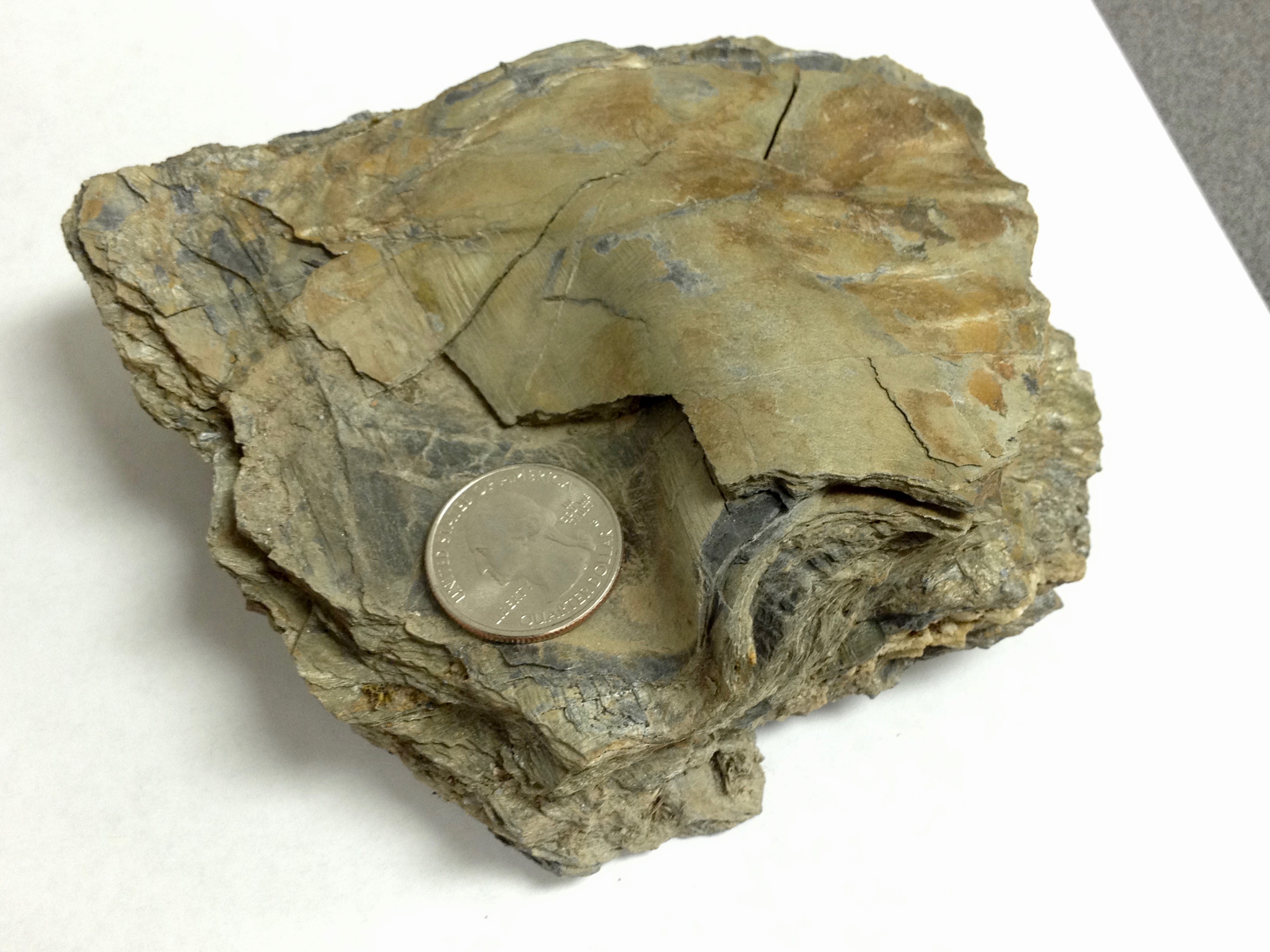
Phyllite is a foliated metamorphic rock in which platy minerals have grown larger and the surface of the foliation shows a sheen from light reflecting from the grains, perhaps even a wavy appearance, called crenulations. Similar to phyllite but with even larger grains is the foliated metamorphic rock schist, which has large platy grains visible as individual crystals. Common minerals are muscovite, biotite, and porphyroblasts of garnets. A porphyroblast is a large crystal of a particular mineral surrounded by small grains. Schistosity is a textural description of foliation created by the parallel alignment of platy visible grains. Some schists are named for their minerals such as mica schist (mostly micas), garnet schist (mica schist with garnets), and staurolite schist (mica schists with staurolite).
![By No machine-readable author provided. Siim assumed (based on copyright claims). [<a href="http://www.gnu.org/copyleft/fdl.html">GFDL</a> or <a href="http://creativecommons.org/licenses/by-sa/3.0/">CC-BY-SA-3.0</a>], <a href="https://commons.wikimedia.org/wiki/File%3AGneiss.jpg">via Wikimedia Commons</a> Alternating bands of light and dark minerals.](https://opengeology.org/textbook/wp-content/uploads/2016/07/06.2_Gneiss.jpg)
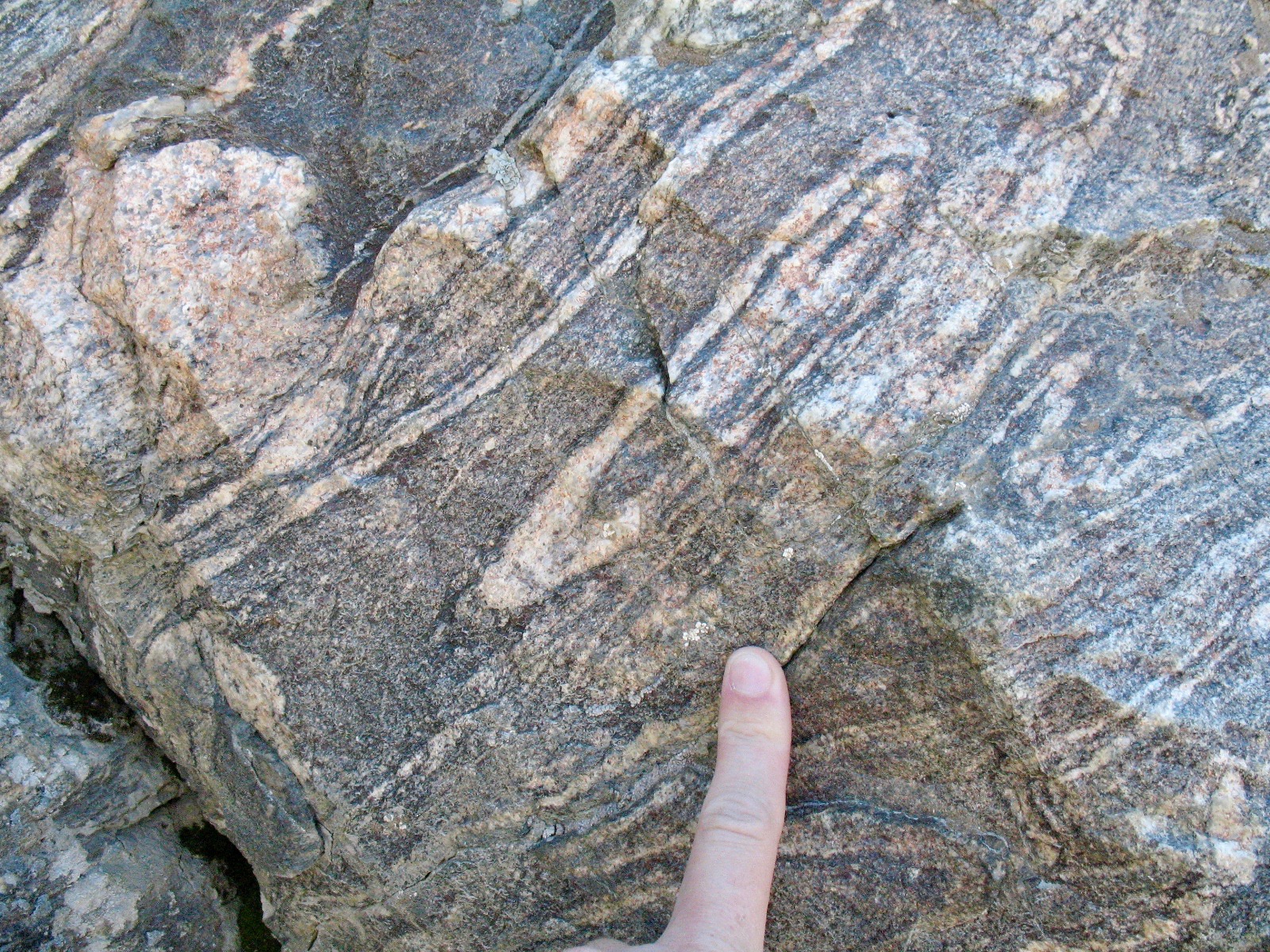
Migmatites appear as dark and light banded gneiss that may be swirled or twisted some since some minerals started to melt. Thin accumulations of light colored rock layers can occur in a darker rock that are parallel to each other, or even cut across the gneissic foliation. The lighter colored layers are interpreted to be the result of the separation of a felsic igneous melt from the adjacent highly metamorphosed darker layers, or injection of a felsic melt from some distance away.
6.2.2 Non-foliated
Non-foliated textures do not have lineations, foliations, or other alignments of mineral grains. Non-foliated metamorphic rocks are typically composed of just one mineral, and therefore, usually show the effects of metamorphism with recrystallization in which crystals grow together, but with no preferred direction. The two most common examples of non-foliated rocks are quartzite and marble. Quartzite is a metamorphic rock from the protolith sandstone. In quartzites, the quartz grains from the original sandstone are enlarged and interlocked by recrystallization. A defining characteristic for distinguishing quartzite from sandstone is that when broken with a rock hammer, the quartz crystals break across the grains. In a sandstone, only a thin mineral cement holds the grains together, meaning that a broken piece of sandstone will leave the grains intact. Because most sandstones are rich in quartz, and quartz is a mechanically and chemically durable substance, quartzite is very hard and resistant to weathering.
Marble is metamorphosed limestone (or dolostone) composed of calcite (or dolomite). Recrystallization typically generates larger interlocking crystals of calcite or dolomite. Marble and quartzite often look similar, but these minerals are considerably softer than quartz. Another way to distinguish marble from quartzite is with a drop of dilute hydrochloric acid. Marble will effervesce (fizz) if it is made of calcite.
A third non-foliated rock is hornfels identified by its dense, fine grained, hard, blocky or splintery texture composed of several silicate minerals. Crystals in hornfels grow smaller with metamorphism, and become so small that specialized study is required to identify them. These are common around intrusive igneous bodies and are hard to identify. The protolith of hornfels can be even harder to distinguish, which can be anything from mudstone to basalt.
[ays_quiz id=”36″]
6.3 Metamorphic Grade
![By Graeme Churchard (GOC53) http://www.flickr.com/people/graeme/ [CC BY 2.0 (http://creativecommons.org/licenses/by/2.0)], via Wikimedia Commons Large weathered garnet crystals in a matrix of platy micas. The garnets are round-shaped with octagonal sides.](https://opengeology.org/textbook/wp-content/uploads/2016/07/06.4_Garnet_Mica_Schist_Syros_Greece.jpg)
Geologists use index minerals that form at certain temperatures and pressures to identify metamorphic grade. These index minerals also provide important clues to a rock’s sedimentary protolith and the metamorphic conditions that created it. Chlorite, muscovite, biotite, garnet, and staurolite are index minerals representing a respective sequence of low-to-high grade rock. The figure shows a phase diagram of three index minerals—sillimanite, kyanite, and andalusite—with the same chemical formula (Al2SiO5) but having different crystal structures (polymorphism) created by different pressure and temperature conditions.
Some metamorphic rocks are named based on the highest grade of index mineral present. Chlorite schist includes the low-grade index mineral chlorite. Muscovite schist contains the slightly higher grade muscovite, indicating a greater degree of metamorphism. Garnet schist includes the high grade index mineral garnet, and indicating it has experienced much higher pressures and temperatures than chlorite.
[ays_quiz id=”37″]
6.4 Metamorphic Environments
As with igneous processes, metamorphic rocks form at different zones of pressure (depth) and temperature as shown on the pressure-temperature (P-T) diagram. The term facies is an objective description of a rock. In metamorphic rocks facies are groups of minerals called mineral assemblages. The names of metamorphic facies on the pressure-temperature diagram reflect minerals and mineral assemblages that are stable at these pressures and temperatures and provide information about the metamorphic processes that have affected the rocks. This is useful when interpreting the history of a metamorphic rock.
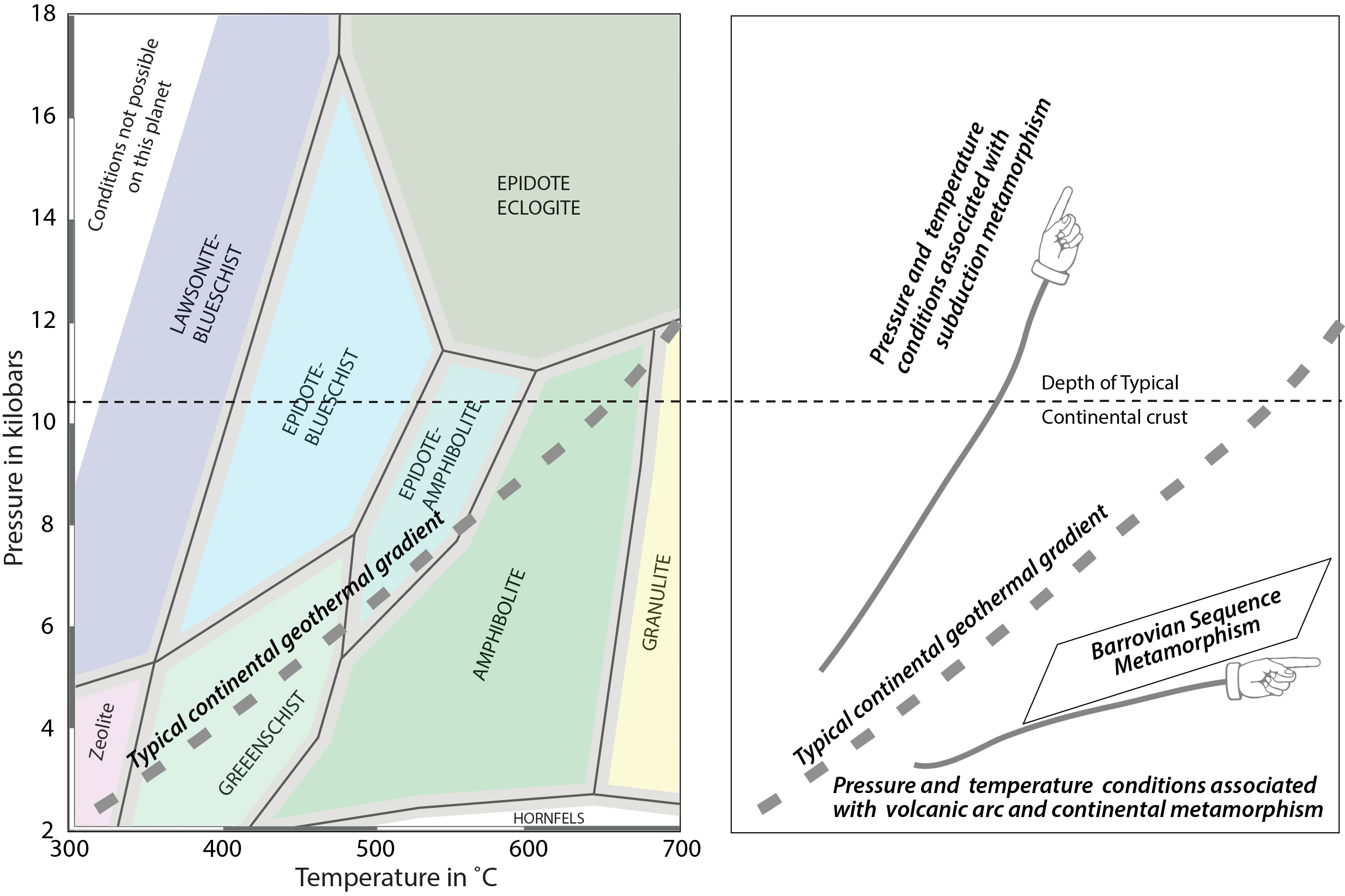
In the late 1800s, British geologist George Barrow mapped zones of index minerals in different metamorphic zones of an area that underwent regional metamorphism. Barrow outlined a progression of index minerals, named the Barrovian Sequence, that represents increasing metamorphic grade: chlorite (slates and phyllites) -> biotite (phyllites and schists) -> garnet (schists) -> staurolite (schists) -> kyanite (schists) -> sillimanite (schists and gneisses).
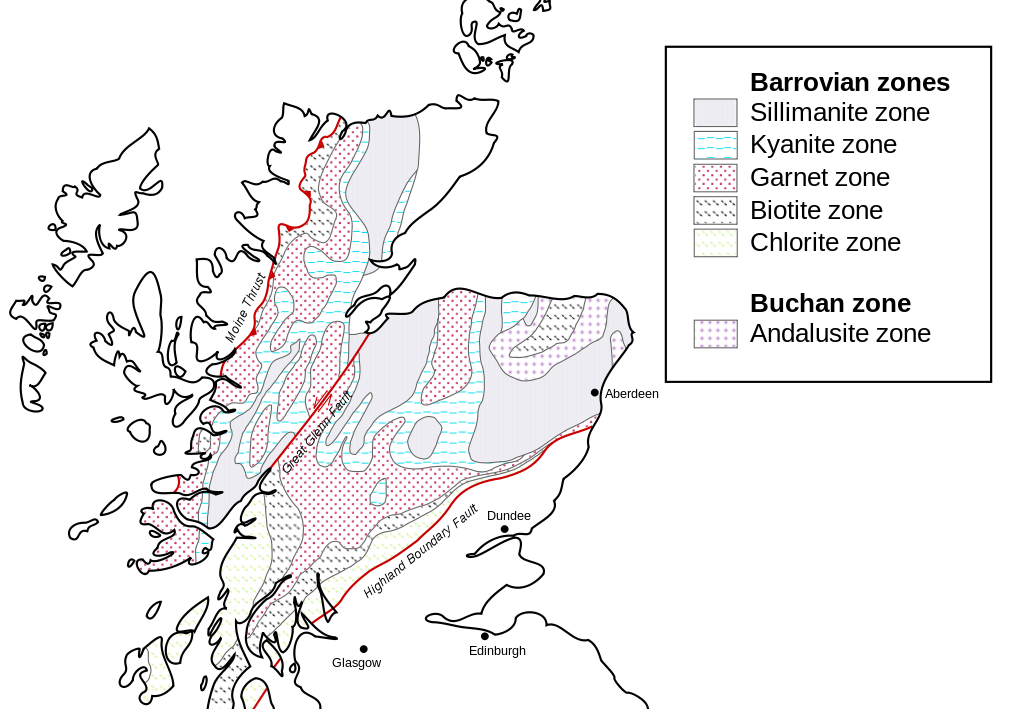
The first of the Barrovian sequence has a mineral group that is commonly found in the metamorphic greenschist facies. Greenschist rocks form under relatively low pressure and temperatures and represent the fringes of regional metamorphism. The “green” part of the name is derived from green minerals like chlorite, serpentine, and epidote, and the “schist” part is applied due to the presence of platy minerals such as muscovite.
Many different styles of metamorphic facies are recognized, tied to different geologic and tectonic processes. Recognizing these facies is the most direct way to interpret the metamorphic history of a rock. A simplified list of major metamorphic facies is given below.
6.4.1 Burial Metamorphism
Burial metamorphism occurs when rocks are deeply buried, at depths of more than 2000 meters (1.24 miles). Burial metamorphism commonly occurs in sedimentary basins, where rocks are buried deeply by overlying sediments. As an extension of diagenesis, a process that occurs during lithification (Chapter 5), burial metamorphism can cause clay minerals, such as smectite, in shales to change to another clay mineral illite. Or it can cause quartz sandstone to metamorphose into the quartzite such the Big Cottonwood Formation in the Wasatch Range of Utah. This formation was deposited as ancient near-shore sands in the late Proterozoic (see Chapter 7), deeply buried and metamorphosed to quartzite, folded, and later exposed at the surface in the Wasatch Range today. Increase of temperature with depth in combination with an increase of confining pressure produces low-grade metamorphic rocks with a mineral assemblages indicative of a zeolite facies.
6.4.2 Contact Metamorphism
Contact metamorphism occurs in rock exposed to high temperature and low pressure, as might happen when hot magma intrudes into or lava flows over pre-existing protolith. This combination of high temperature and low pressure produces numerous metamorphic facies. The lowest pressure conditions produce hornfels facies, while higher pressure creates greenschist, amphibolite, or granulite facies.
As with all metamorphic rock, the parent rock texture and chemistry are major factors in determining the final outcome of the metamorphic process, including what index minerals are present. Fine-grained shale and basalt, which happen to be chemically similar, characteristically recrystallize to produce hornfels. Sandstone (silica) surrounding an igneous intrusion becomes quartzite via contact metamorphism, and limestone (carbonate) becomes marble.
![By Random Tree (Own work) [<a href="http://creativecommons.org/publicdomain/zero/1.0/deed.en">CC0</a>], <a href="https://commons.wikimedia.org/wiki/File%3AMetamorphic_Aureole_in_the_Henry_Mountains.JPG">via Wikimedia Commons</a> Altered rock adjacent to an igneous intrusion.](https://opengeology.org/textbook/wp-content/uploads/2016/07/Metamorphic_Aureole_in_the_Henry_Mountains.jpg)
6.4.3 Regional Metamorphism
Regional metamorphism occurs when parent rock is subjected to increased temperature and pressure over a large area, and is often located in mountain ranges created by converging continental crustal plates. This is the setting for the Barrovian sequence of rock facies, with the lowest grade of metamorphism occurring on the flanks of the mountains and highest grade near the core of the mountain range, closest to the convergent boundary.
An example of an old regional metamorphic environment is visible in the northern Appalachian Mountains while driving east from New York state through Vermont and into New Hampshire. Along this route the degree of metamorphism gradually increases from sedimentary parent rock, to low-grade metamorphic rock, then higher-grade metamorphic rock, and eventually the igneous core. The rock sequence is sedimentary rock, slate, phyllite, schist, gneiss, migmatite, and granite. In fact, New Hampshire is nicknamed the Granite State. The reverse sequence can be seen heading east, from eastern New Hampshire to the coast.
6.4.4 Subduction Zone Metamorphism
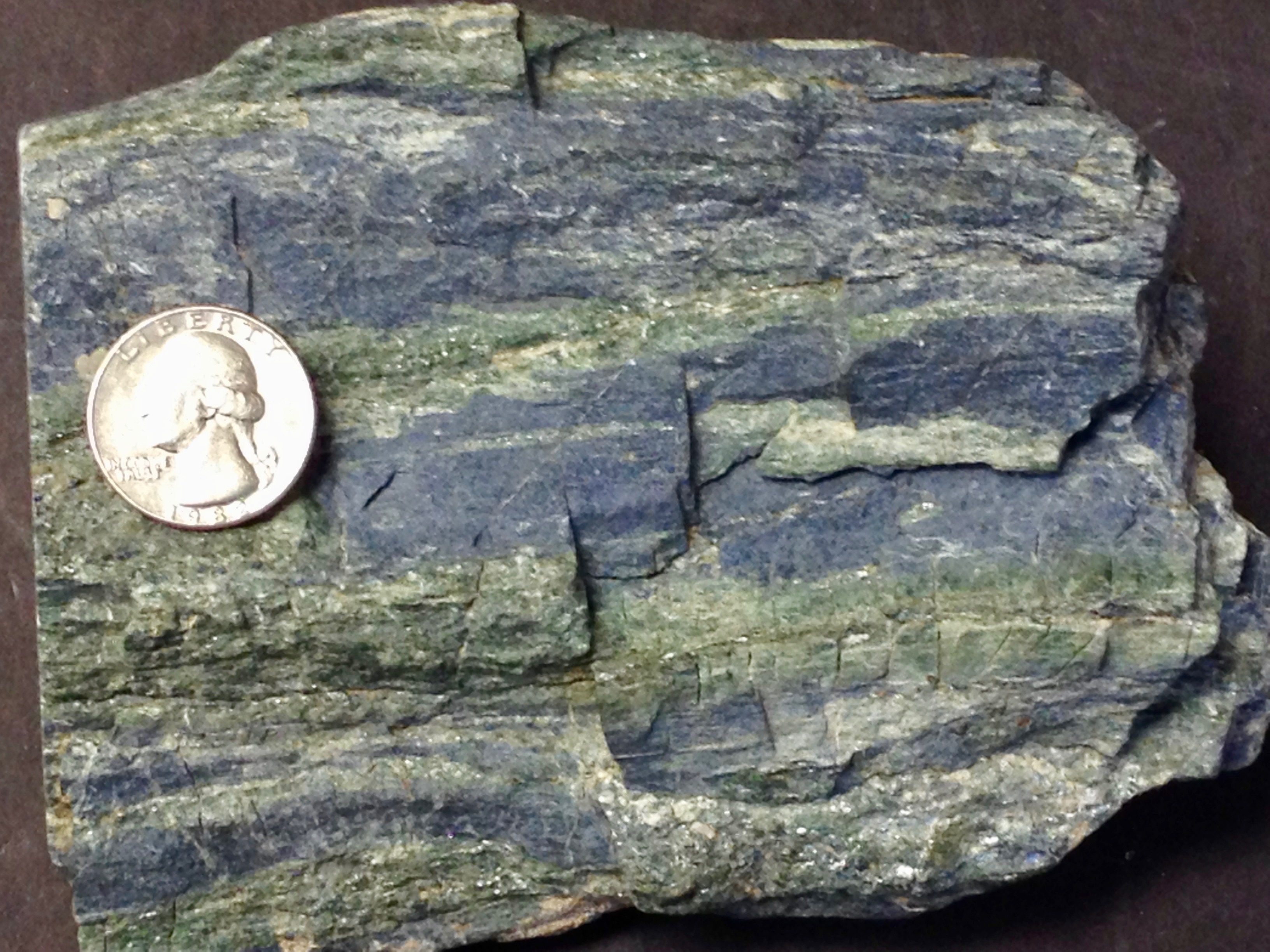
Subduction zone metamorphism is a type of regional metamorphism that occurs when a slab of oceanic crust is subducted under continental crust (see Chapter 2). Because rock is a good insulator, the temperature of the descending oceanic slab increases slowly relative to the more rapidly increasing pressure, creating a metamorphic environment of high pressure and low temperature. Glaucophane, which has a distinctive blue color, is an index mineral found in blueschist facies (see metamorphic facies diagram). The California Coast Range near San Francisco has blueschist-facies rocks created by subduction-zone metamorphism, which include rocks made of blueschist, greenstone, and red chert. Greenstone, which is metamorphized basalt, gets its color from the index mineral chlorite.
6.4.5 Fault Metamorphism
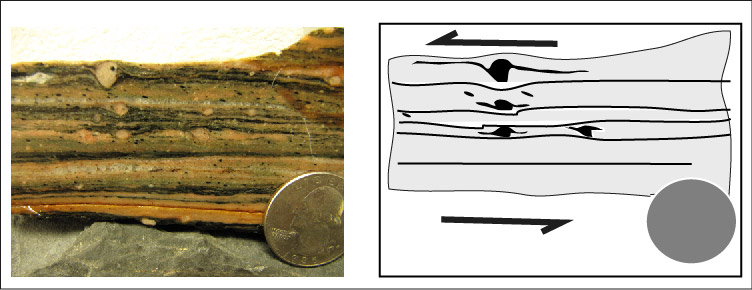
There are a range of metamorphic rocks made along faults. Near the surface, rocks are involved in repeated brittle faulting produce a material called rock flour, which is rock ground up to the particle size of flour used for food. At lower depths, faulting create cataclastites, chaotically-crushed mixes of rock material with little internal texture. At depths below cataclasites, where strain becomes ductile, mylonites are formed. Mylonites are metamorphic rocks created by dynamic recrystallization through directed shear forces, generally resulting in a reduction of grain size. When larger, stronger crystals (like feldspar, quartz, garnet) embedded in a metamorphic matrix are sheared into an asymmetrical eye-shaped crystal, an augen is formed.
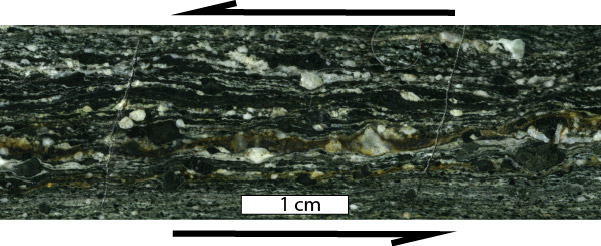
6.4.6 Shock Metamorphism
![By Glen A. Izett [Public domain], <a href="https://commons.wikimedia.org/wiki/File%3A820qtz.jpg">via Wikimedia Commons</a> A small grain of sand showing a prismatic inside with lines across it.](https://opengeology.org/textbook/wp-content/uploads/2016/07/820qtz.jpg)
![By JMGastonguay (Own work) [CC BY-SA 4.0 (http://creativecommons.org/licenses/by-sa/4.0)], via Wikimedia Commons Shatter cones are cone-shaped features, that show lines that converge to cone shapes.](https://opengeology.org/textbook/wp-content/uploads/2016/07/06.4_ShatterConeCharlevoix1.jpg)
Shock metamorphism can also produce index minerals, though they are typically only found via microscopic analysis. The quartz polymorphs coesite and stishovite are indicative of impact metamorphism. As discussed in chapter 3, polymorphs are minerals with the same composition but different crystal structures. Intense pressure (> 10 GPa) and moderate to high temperatures (700-1200 °C) are required to form these minerals.
![I, Brocken Inaglory [GFDL (http://www.gnu.org/copyleft/fdl.html), CC-BY-SA-3.0 (http://creativecommons.org/licenses/by-sa/3.0/) or CC BY-SA 2.5-2.0-1.0 (http://creativecommons.org/licenses/by-sa/2.5-2.0-1.0)], via Wikimedia Commons Teardrop-shaped glass that looks like obsidian.](https://opengeology.org/textbook/wp-content/uploads/2016/07/06.4_Two_tektites.jpg)
[ays_quiz id=”38″]
Summary
Metamorphism is the process that changes existing rocks (called protoliths) into new rocks with new minerals and new textures. Increases in temperature and pressure are the main causes of metamorphism, with fluids adding important mobilization of materials. The primary way metamorphic rocks are identified is with texture. Foliated textures come from platy minerals forming planes in a rock, while non-foliated metamorphic rocks have no internal fabric. Grade describes the amount of metamorphism in a rock, and facies are a set of minerals that can help guide an observer to an interpretation of the metamorphic history of a rock. Different tectonic or geologic environments cause metamorphism, including collisions, subduction, faulting, and even impacts from space.
[ays_quiz id=”39″]
References
- Bucher, K., and Grapes, R., 2011, Petrogenesis of metamorphic rocks: Springer, 341 p.
- Jeong, I.-K., Heffner, R.H., Graf, M.J., and Billinge, S.J.L., 2003, Lattice dynamics and correlated atomic motion from the atomic pair distribution function: Phys. Rev. B Condens. Matter, v. 67, no. 10, p. 104301.
- Marshak, S., 2009, Essentials of Geology, 3rd or 4th Edition:
- Proctor, B.P., McAleer, R., Kunk, M.J., and Wintsch, R.P., 2013, Post-Taconic tilting and Acadian structural overprint of the classic Barrovian metamorphic gradient in Dutchess County, New York: Am. J. Sci., v. 313, no. 7, p. 649–682.
- Timeline of Art History, 2007, Reference Reviews, v. 21, no. 8, p. 45–45.

![By Uta Baumfelder at de.wikipedia (Own work) [Public domain], <a href="https://commons.wikimedia.org/wiki/File%3AEhemaliger_Schiefertagebau_am_Brand.JPG">via Wikimedia Commons</a> Rock breaking along flat even planes.](https://opengeology.org/textbook/wp-content/uploads/2016/07/06.2-Ehemaliger_Schiefertagebau_am_Brand.jpg)

![Source: By Michael C. Rygel (Own work) [CC BY-SA 3.0 (http://creativecommons.org/licenses/by-sa/3.0)], via Wikimedia Commons Schist is a scalely looking foliated metamorphic rock.](https://opengeology.org/textbook/wp-content/uploads/2016/07/06.2-Schist_detail-e1492392805920.jpg)
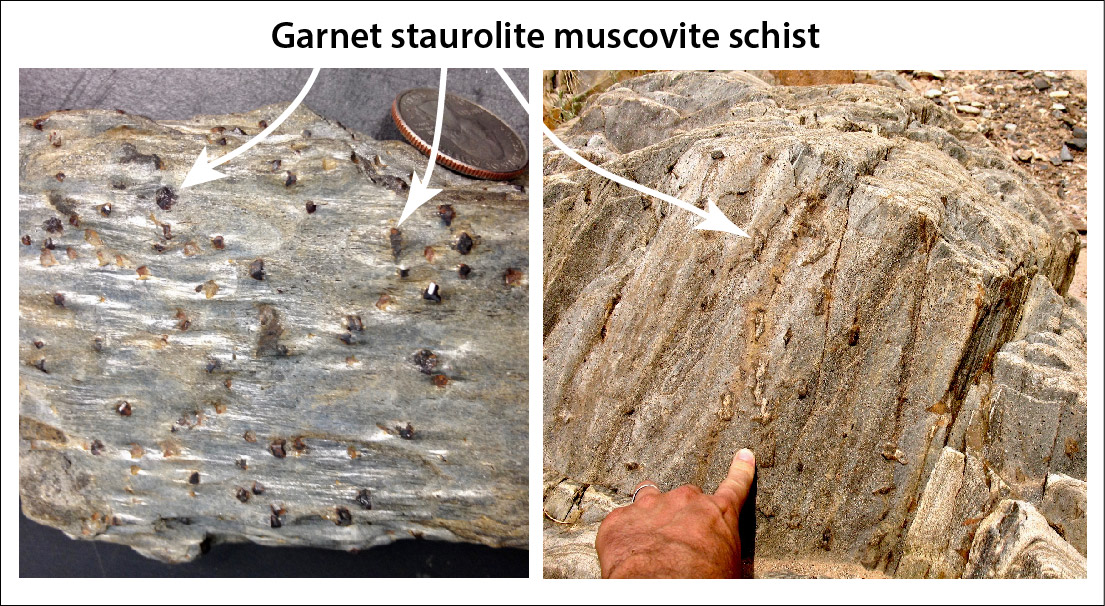
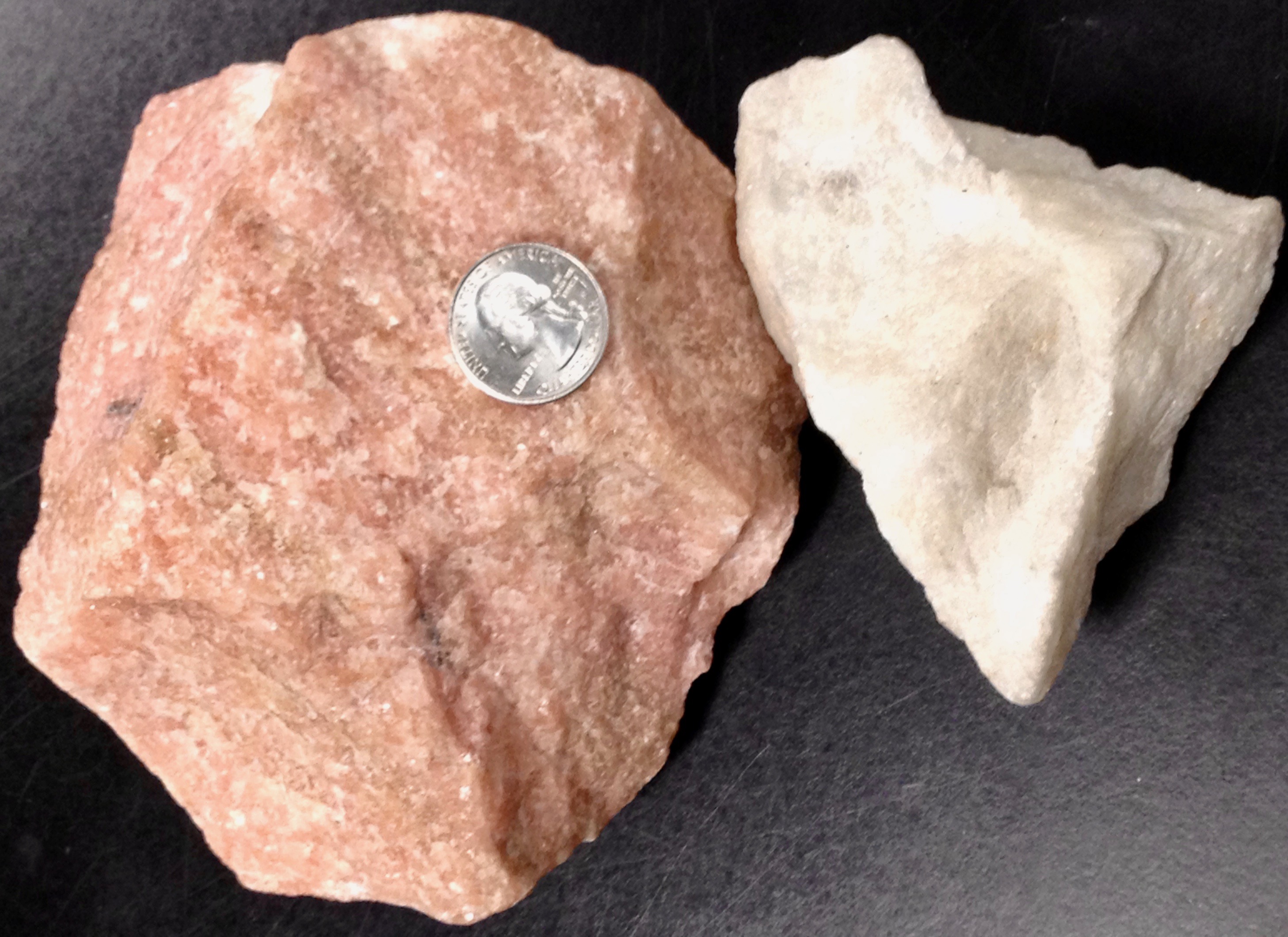

![By Manishwiki15 (Own work) [CC BY-SA 3.0 (http://creativecommons.org/licenses/by-sa/3.0)], via Wikimedia Commons Interlocking quartz grains in a quartzite.](https://opengeology.org/textbook/wp-content/uploads/2016/07/Sample_of_Quartzite-e1493780752118.jpg)
![By Wilson44691 (Own work) [Public domain], via Wikimedia Commons Undeformed quartz grains do not interlock.](https://opengeology.org/textbook/wp-content/uploads/2016/07/640px-CoralPinkSandDunesSand.jpg)